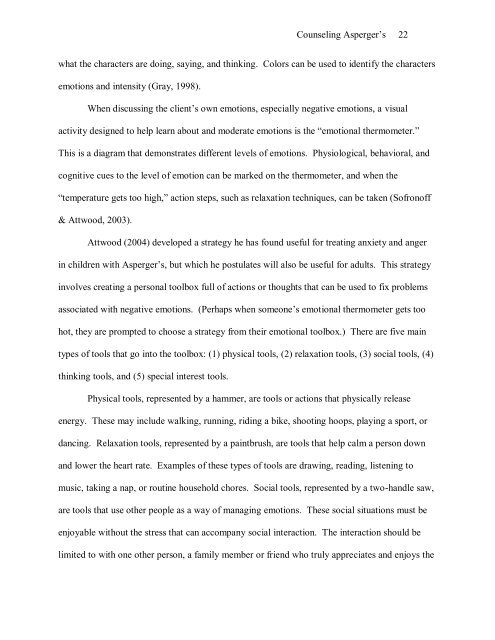COUNSELING ADULTS WITH ASPERGER‟S - School of Health ...
COUNSELING ADULTS WITH ASPERGER‟S - School of Health ...
COUNSELING ADULTS WITH ASPERGER‟S - School of Health ...
You also want an ePaper? Increase the reach of your titles
YUMPU automatically turns print PDFs into web optimized ePapers that Google loves.
Counseling Asperger‟s 22<br />
what the characters are doing, saying, and thinking. Colors can be used to identify the characters<br />
emotions and intensity (Gray, 1998).<br />
When discussing the client‟s own emotions, especially negative emotions, a visual<br />
activity designed to help learn about and moderate emotions is the “emotional thermometer.”<br />
This is a diagram that demonstrates different levels <strong>of</strong> emotions. Physiological, behavioral, and<br />
cognitive cues to the level <strong>of</strong> emotion can be marked on the thermometer, and when the<br />
“temperature gets too high,” action steps, such as relaxation techniques, can be taken (S<strong>of</strong>ron<strong>of</strong>f<br />
& Attwood, 2003).<br />
Attwood (2004) developed a strategy he has found useful for treating anxiety and anger<br />
in children with Asperger‟s, but which he postulates will also be useful for adults. This strategy<br />
involves creating a personal toolbox full <strong>of</strong> actions or thoughts that can be used to fix problems<br />
associated with negative emotions. (Perhaps when someone‟s emotional thermometer gets too<br />
hot, they are prompted to choose a strategy from their emotional toolbox.) There are five main<br />
types <strong>of</strong> tools that go into the toolbox: (1) physical tools, (2) relaxation tools, (3) social tools, (4)<br />
thinking tools, and (5) special interest tools.<br />
Physical tools, represented by a hammer, are tools or actions that physically release<br />
energy. These may include walking, running, riding a bike, shooting hoops, playing a sport, or<br />
dancing. Relaxation tools, represented by a paintbrush, are tools that help calm a person down<br />
and lower the heart rate. Examples <strong>of</strong> these types <strong>of</strong> tools are drawing, reading, listening to<br />
music, taking a nap, or routine household chores. Social tools, represented by a two-handle saw,<br />
are tools that use other people as a way <strong>of</strong> managing emotions. These social situations must be<br />
enjoyable without the stress that can accompany social interaction. The interaction should be<br />
limited to with one other person, a family member or friend who truly appreciates and enjoys the


